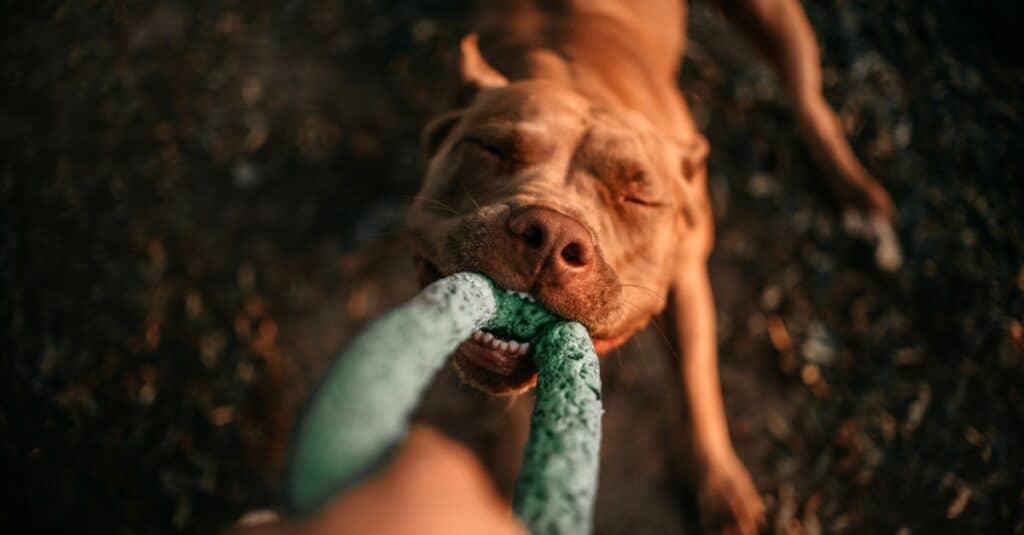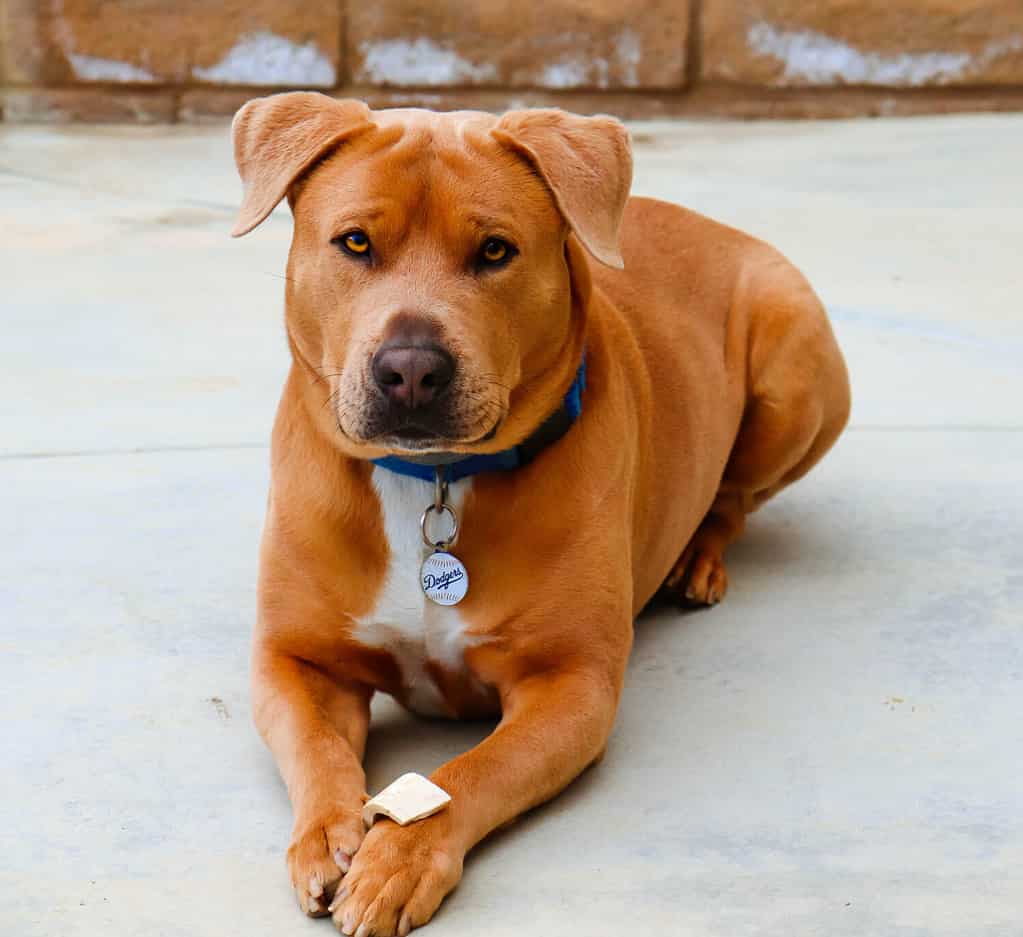If you’re planning on adopting a pit bull and golden retriever mix, you may be wondering what the most crucial aspects of each breed are to support a healthy, happy pup.
Currently, the American Staffordshire terrier is recognized by several major kennel clubs, while the AKC does not recognize the American pit bull terrier as a breed. However, the United Kennel Club does accept both breeds. In this guide, when we talk about the “golden pit”, we’ll refer to the crossing of a golden retriever with either an American Staffordshire terrier or an American pit bull terrier.
Read on to learn all about this lovely mixed breed and tips for raising a well-rounded, content dog.
Breed Summaries of Pit Bulls and Golden Retrievers
The breed histories for pit bulls and golden retrievers are quite opposing. While Dudley Marjoribanks created the golden retriever in 1868 to be an adaptable, family-friendly hunting dog of Scotland’s high society, the American Staffordshire terrier and American pit bull terrier arose in the late 1800s from a lineage of British dogs cruelly bred to fight their kind.
In addition to historical origin, the body types of the golden retriever and pit bulls deviate from each other significantly as well.
Golden Retriever Characteristics
For the graceful water and land-based hunting dog, breeders of golden retrievers selected for features such as a moderately long and dense, water-repellent coat, a symmetrical build, a deep and broad skull, friendly and expressive eyes, a level top-line, flowing, freely moving gait, and a generally friendly disposition towards other dogs and humans. Golden retrievers often enjoy water-based enrichment and fetching games.

Originating in Scotland in the 19th century, the golden retriever is now one of the most popular family dogs in the U.S.
©Joop Snijder Photography/Shutterstock.com
Pit Bull Characteristics
For the American Staffordshire terrier and American pit bull terrier, breeders sought features of a stocky, bull-terrier-type dog that exudes strength, courage, and alertness. Overall, the body type should be well-balanced, agile, and strong. The skull should be broad, the neck heavy and slightly arched, and the shoulder blades wide and muscular. The jaws should be well-defined and cheek muscles distinctly pronounced.
Pit bulls should have a short, stiff coat of any color or combination. Historically, breeders selected dogs that were overwhelmingly friendly to people but uncomfortable around other dogs. Today, plenty of pit bulls are perfectly friendly with other dogs, especially when compassionately socialized during their crucial early socialization period. Pit bulls aren’t typically known for their love of water, although like golden retrievers, many individuals of this breed enjoy fetching games and similar activities such as tug-of-war.

Courageous, energetic, and people-oriented, pit bulls are wonderful, highly affectionate dogs.
©Diego Thomazini/Shutterstock.com
Attributes of a Pit Bull and Golden Retriever Mix
The genetics of a dog can certainly influence but does not set in stone, the personality or interests of an individual. Early socialization, home and upbringing environment, type of training used, health, the type of bond formed with the primary human caregiver, and if basic species-specific needs are met throughout their life, also play significant roles in influencing the behavior of a dog.
This mix, also known as the “golden pit”, is not commonly intentionally bred, but may be rising in popularity as society becomes more compassionate and accepting of the various loving and wonderful pit bull breeds. Keeping in mind the understanding that genetics only influences dog behavior to a degree, folks often attribute both golden retrievers and pit bulls to being exceedingly people-friendly and snuggly pups. “Pitties” and “pibbles” are both terms of endearment that emphasize the sweet, cuddly, and loving nature of these dogs. Raised with love, guidance, and enrichment, you’d likely find your golden pibble to be quite the snuggly, playful pup.

A pit bull and golden retriever mix is a wonderful combination of two friendly, loving, and energetic breeds.
©saulocbarreto/Shutterstock.com
Enrichment for a Pit Bull and Golden Retriever Mix
There are several activities your golden pit may enjoy partaking in with you. Below, we’ll talk about water-based enrichment, fetch and catch, tug-of-war, and food-based activities.
Water-Based Enrichment
With their golden retriever genes, it’s certainly worth investigating if your golden retriever and pit bull mix enjoys water-based enrichment. Whether the golden pit is a puppy or adult, however, it’s crucial to never force your dog into a river or lake simply because you hope they’ll have fun. Instead, it’s best to find a shallow area where your dog can easily wade in and allow them the choice of entering the water.
You may find that your pup is more willing to investigate the water if you go in first. They may immediately love the water or need to build up confidence in wading or swimming over many trips. Or, your golden pit pup may simply not enjoy water-based enrichment. The anatomy of pit bulls doesn’t correlate to easy swimming, so if the build of your dog resembles a pit bull more than a golden retriever, you might find that they are less interested in swimming. However, they may still enjoy wading, running through sprinklers, or wallowing in muddy puddles.

As a golden retriever cross, your golden pit might have an innate love for water-based enrichment.
©demanescale/Shutterstock.com
Fetch and Catch
Playing gentle fetch and catch can be great games for a golden pit. This mixed breed will likely enjoy playing games that involve carrying or pulling toys. If your dog seems to enjoy fetching balls, it’s important to not go overboard. Ball obsession can be quite debilitating for dogs and can lead to arthritic changes through repeated micro damage caused by rapid de-accelerations, twisting in the air, and direction changes. Especially since both breeds can be prone to hip dysplasia, it’s crucial to not engage in more than a few minutes of gentle ball throwing. If your golden pit enjoys fetching or carrying balls, you can supplement ball throwing by hiding the ball for your dog to find or throwing it in water since swimming is much gentler on joints.
Tug-of-War
Tug-of-war is a game your pit bull and golden retriever mix might enjoy. Pit bulls tend to love holding on and pulling items with their mouth. Tug-of-war can be a great outlet for this desire. When playing any game that involves your dog holding something in their mouth, it’s a good idea to teach them to drop the item upon request. The best way to teach this is through offering a trade every time your request a drop or handing back the toy after they’ve given it to you. This way, your golden pit will know that you won’t simply take items from them and end their fun, and as such, they’ll be much more willing and happy to drop items for you.

Pit bulls often love playing games like tug-of-war. You may find that your golden retriever and pit bull mix adores this high-energy game.
©iStock.com/Ksenia Raykova
Food Enrichment
Both golden retrievers and pit bulls are often associated with being quite food motivated. This food motivation can be an excellent basis for positive reinforcement training, and it can also be a great reason to set up food-based enrichment for your golden pit. When setting up food-based enrichment, you can also encourage sniffing and licking, which are calming activities for dogs. Giving your pup a peanut-butter-covered lickimat, hiding lots of tiny treats in a snuffle mat, or scatter-feeding kibble in the yard are all examples of using food to engage your dog’s senses and enrich their lives. Some pit bulls tend to scarf down their meals, so you also might find that your golden pit may benefit from the use of a slow feeder.
Size Range of a Pit Bull and Golden Retriever Mix
According to the AKC, the American Staffordshire terrier should stand between 17-19 inches tall at the shoulder. Males should weigh 55-70 pounds and females should weigh between 40-55 pounds. By the UKC’s standards, a female American pit bull terrier should weigh 30-50 pounds and a male should weigh in at 35-60 pounds. A male American pit bull terrier should stand 18-21 inches at the withers, and females typically measure 17-20 inches. Finally, the AKC weight range for a female golden retriever is 55-65 pounds, and the male weight is 65-75 pounds. Adult female golden retrievers typically stand 21.5-22.5 inches tall at the withers while adult males should measure 23-24 inches.
Given this information, it’s difficult to determine the narrow height and weight range that a golden pit puppy may grow to in adulthood. However, you might see a weight range between 30-75 pounds and a height at the withers of 17-24 inches.
The best way to approximate what size your golden pit puppy will reach in adulthood is to regularly take them to developmental checkups at your vet. If you’re adopting a golden retriever and pit bull mix as a puppy, make sure to provide a calorie-dense, nutritious puppy food to support healthy development.

Your pit bull and golden retriever mix will likely weigh between 30-75 pounds when full-grown.
©Chivachuck/Shutterstock.com
Common Health Issues and Average Life Span
As a mixed breed dog, your golden pit will likely have overall healthier genetics than a purebred. However, there are some health conditions that both pit bulls and golden retrievers face an increased risk of developing or being born with. As such, a golden retriever and pit bull mix may be genetically predisposed to developing the following conditions:
- Hip dysplasia
- Elbow dysplasia
- Hypothyroidism
- Skin allergies
If you notice that your golden pit seems to be suffering from clinical signs or is exhibiting a sudden behavioral shift, it’s a good idea to set up a vet appointment or contact a qualified, force-free behaviorist. Additionally, since the risk of joint disorders is high for both pit bulls and golden retrievers, it’s important to speak to your vet about supplements and diets that may support and protect joint health.
Average Life Span
On average, you can expect your golden retriever to live 10-12 years. Sadly, this modern life span is shorter than it once was for the breed. Some researchers believe golden retrievers are developing certain cancers at a much higher rate than their predecessors. American Staffordshire terriers have an average life span of about 14-16 years, and American pit bull terriers follow at about 10-14 years.
Likely, you can expect a life span of 10-15 years for your golden retriever and pit bull mix. Supporting a long, healthy life for this mixed breed entails providing a whole and balanced diet, supporting their joint health, and making sure their species-specific canine needs are met.
The photo featured at the top of this post is © Oscity/Shutterstock.com
Ready to discover the top 10 cutest dog breeds in the entire world?
How about the fastest dogs, the largest dogs and those that are -- quite frankly -- just the kindest dogs on the planet? Each day, AZ Animals sends out lists just like this to our thousands of email subscribers. And the best part? It's FREE. Join today by entering your email below.
Thank you for reading! Have some feedback for us? Contact the AZ Animals editorial team.







